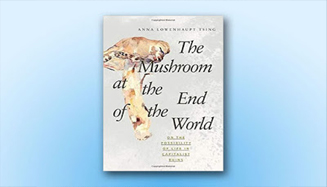
Anthropologist Anna Lowenhaupt Tsing’s The Mushroom at the End of the World is a rich multispecies ethnography, traces the growth of a particular kind of Mushroom (matsutake mushroom) in the age of capitalism, and in a way emphasises on the relation between humans and nonhuman beings that go into matsutake mushroom foraging, exporting and consumption.
The preface, aptly titled Enabling Entanglements, explains the shifts in the way nature is understood over time. Nature is always seen as universal and passive, which could be tamed. Eventually, the shift happened that enabled looking into the entanglements of different living species. The human-centric science scholarship slowly took into consideration the importance of nonhuman interventions. Based on fieldwork between 2004 and 2011 on the aromatic matsutake mushroom of Japanese origin, Tsing tries to discuss these entanglements through a “riot of short chapters that are like flushes of mushrooms after rain” (p. viii). Growing particularly in human-disturbed forests, which in the book are explained as fallouts of capitalism, matsutake mushrooms show resilience and the lateral relations amongst various species – be it humans, red pine trees, fungi and nematodes. This approach, which focuses on interactive relations among humans and nonhumans allows the readers to rethink ideas of rationalisations, wherein nonhumans are subordinated by human activities. As shapers of the world, the relations of matsutake mushroom, pine, fungi and nematodes deserve much more recognition.
By tracing the growth of matsutake mushroom, Tsing also highlights the multiple layers of interactions and dependency within the humans. While matsutake foragers belong to cultural minorities and refugees (which includes the white American antifederalist and Vietnam War veterans seeking refuge in the forest, as well as Hmong, Mien, and Khmer immigrants from war-torn parts of Southeast Asia), its consumers were mainly from the aristocrat class as not many could not afford this special Mushroom growing in the shade of red pines. Matsutake had become a luxury item, used as perks, gifts or bribes (p. 67). Later, to cater to the growing demands, in 1980s matsutake mushrooms were imported from the United States. Hinting at the social stratification and how in a way stratification is further reproduced through the mushroom commerce, Tsing emphasises that world-making is about collaborations.
Spending time in Oregon, in the U.S. Pacific Northwest, Tsing showed across a few chapters that imports led to the development of supply chains – something as inconsequential as Mushroom has linked individuals and economies across continents. In the process, the mushroom business has provided some meaningful employment to the migrant and refugee foragers. Still, more importantly, it enabled freedom from war and violence that otherwise disturbed their lives. As a species that grows in the degraded environments, matsutake mushroom stands as a symbol of hope in a modern capitalist world that is inherently characterised by despair and “terrors of indeterminacy” (p.1). The process of foraging, packaging and exporting the mushrooms sees the matsutake’s journey from an alienated commodity, a kula-like gifting commodity to finally as “trophy of freedom” (p. 127).
Tsing hints at the crux of the book when she says, “Making world is not limited to humans” (22), for her world-making projects, may overlap, allowing multiple species to work together. Accepting this intersection leaves no scope to maintain a hierarchical binary of humans over nature. The book is an addition to the growing genre of multispecies ethnography that moves beyond the human-nature binary. It wishes to start, or at the least take forward a conversation on the said perspective. At around 300 pages, this book is also one that tries to find hope in capitalism, unlike many others. By using a simple language, Tsing’s book becomes readable for a wider audience. The photographs at the beginning of each of the few sections also help in this direction. Midway through the book, Tsing acknowledges “big histories are always best told through insistent if humble, details” (p.111). However, few parts, somewhere in the third section, may overwhelm the reader with its rich factual account – an issue which can be otherwise be dealt with reading the book in parts. Above all, the book is important for those interested in understanding relations of nature and society, the multispecies perspective of looking at the world and ethnographies in general.
***
Sampurna Das is a doctoral candidate at the Department of Sociology, Delhi School of Economics (DSE), University of Delhi, India.
